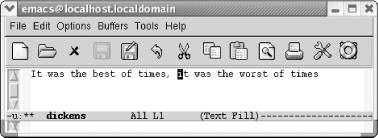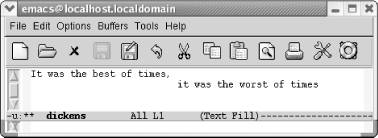
GNU Emacs is the most popular and widespread of the Emacs family of editors. It is also the most powerful and flexible. Unlike all other text editors, GNU Emacs is a complete working environment—you can stay within Emacs all day without leaving.
, 3rd Edition tells readers how to get started with the GNU Emacs editor. It is a thorough guide that will also "grow" with you: as you become more proficient, this book will help you learn how to use Emacs more effectively. It takes you from basic Emacs usage (simple text editing) to moderately complicated customization and programming.The third edition of
describes Emacs 21.3 from the ground up, including new user interface features such as an icon-based toolbar and an interactive interface to Emacs customization. A new chapter details how to install and run Emacs on Mac OS X, Windows, and Linux, including tips for using Emacs effectively on those platforms.
, third edition, covers:
Learning GNU Emacs
Learning GNU Emacs
Learning GNU Emacs
• How to edit files with Emacs
• Using the operating system shell through Emacs
• How to use multiple buffers, windows, and frames
• Customizing Emacs interactively and through startup files
• Writing macros to circumvent repetitious tasks
• Emacs as a programming environment for Java, C++, and Perl, among others
• Using Emacs as an integrated development environment (IDE)
• Integrating Emacs with CVS, Subversion and other change control systems for projects with multiple developers
• Writing HTML, XHTML, and XML with Emacs
• The basics of Emacs Lisp
The book is aimed at new Emacs users, whether or not they are programmers. Also useful for readers switching from other Emacs implementations to GNU Emacs.
7.2.3.2 Other indentation tricks
7.2.3.2 Other indentation tricks
Whenever you are using indentation, you can use M-m (for back-to-indentation) to move to the first nonblank character on a line. On a line that's not indented, this command simply moves you to the beginning of the line. In other words, M-m brings you to the "logical" beginning of the line, which is what you usually mean when you type C-a.
Another indentation command is C-M-o (for split-line). You can use this command to create a stairstep effect. Move the cursor to the text that you want to put on the next line and press C-M-o. Note that there must be some text following the cursor in order for this command to work properly; if you try it at the end of a line, it does nothing.
Initial state:
We want to split this line.
Type: C-M-o
C-M-o splits the line at the cursor position.






